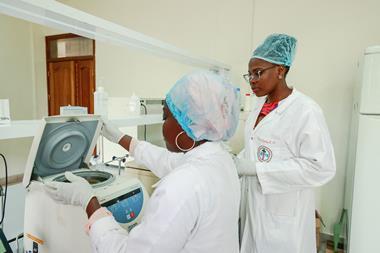Understanding why individuals from lower socioeconomic backgrounds are underrepresented in the chemical sciences

Social class bias exists in every major economy. However, compared to other developed nations the UK is third bottom for social mobility, and at its worst in over 50 years. This has been exacerbated by learning losses and declining motivation to study following the Covid-19 pandemic.
The social and economic conditions a person grows up in, including income, education and social status, significantly impacts access to education, career opportunities and life outcomes. Too often, socioeconomic inclusion has nothing to do with ability and everything to do with access. For example, workers from a low socioeconomic background are 32% less likely to become managers than those from a high socioeconomic background.
These themes are mirrored in the chemical sciences. At the Royal Society of Chemistry (RSC), our socioeconomic inclusion landscape analysis, supported by the Chemists’ Community Fund, indicates that individuals from low socioeconomic backgrounds are underrepresented and disproportionately experience barriers to progression within the chemical sciences. Barriers include regional inequalities, limited access to guidance and mentorship, restricted opportunities and resources, and a lack of representation across the chemical sciences field.
Yet socioeconomic inclusion is often missing from inclusion and diversity (I&D) programmes, despite 9 out of 10 adults agreeing that it is important to level the playing field and improve social mobility in the UK. Some also argue that current I&D programmes offer very little to White working class men, leading to feelings of exclusion and further entrenching social divides.
No one belongs in the chemical sciences more than you
Measuring socioeconomic background is the critical first step to improve socioeconomic inclusion in the chemical sciences. However, socioeconomic background does not have a simple definition that explains the role it plays on career trajectory and reflects the ingrained regional inequalities and persistent barriers for those from minoritised and marginalised backgrounds. This couples with an uneasiness to define who we are and where we have come from.
The social mobility commission has established a common, industry standard across multiple career backgrounds, which gives a firm basis to develop and inform socioeconomic inclusion work in the chemical sciences.
- What was the occupation of your main household earner when you were about aged 14?
- Which type of school did you attend for the most time between the ages of 11 and 16?
- If you finished school after 1980, were you eligible for free school meals at any point during your school years?
- Did either of your parents attend university and gain a degree (e.g. BA/BSc or equivalent) by the time you were 18?
Inclusion is like tending a garden—every plant thrives differently
Socioeconomic inclusion is about recognising that people need different kinds of support to truly thrive. As Audre Lorde said: ‘There is no such things as a single-issue struggle because we do not live single-issue lives.’
From the RSC’s previous I&D work, we know that female scientists who stay in academia are not progressing, with anecdotal evidence of bullying and harassment. The loss of women is most pronounced for Black women with a sharp attrition of Black chemists after undergraduate. Many LGBT+ people do not find the physical sciences to be a comfortable working environment and have considered leaving. Disabled people, and those with an impairment or health condition are underrepresented within the chemical sciences.
Rather than viewing socioeconomic inclusion in isolation, we must adopt an intersectional perspective that acknowledges how overlapping forms of discrimination, disadvantage and privilege shape the experiences of marginalised or underrepresented individuals.
Our socioeconomic inclusion work so far
While our landscape analysis has revealed key issues, it has also exposed gaps in our understanding of socioeconomic inclusion, such as gaps in quantitative data, lack of representative data across career stages, sectors and regions, and, most importantly, the underlying ‘how’ and ‘why’ that quantitative data alone cannot answer.
To address these, we are investigating how socioeconomic background affects undergraduate students in the chemical sciences across UK higher educations, including students of all nationalities and learning pathways. Our qualitative research is not just about understanding the challenges, it is about finding solutions. By prioritising lived experiences, we can craft strategies that are not only evidence based but also empathetic, inclusive, and transformative.
We know that social and economic inequalities are limiting the aspirations and career choices of some young people and widening the education gap. However socioeconomic status has become the main I&D topic that working professions are actively avoiding through fear of getting something wrong.
We must break the collective silence by speaking with one voice about strength, community, and solutions. We need new ways to inspire and empower action, that avoids fear or guilt tactics and is driven by both quantitative and qualitative evidence.
By equipping the chemical sciences community with the skills and knowledge that ignite meaningful conversations, we drive meaningful change that not only empowers the individual but also fuels economic growth and drives scientific advancement.
Take action and find support
If you’re an RSC member requiring support, contact the Chemists’ Community Fund Wellbeing and Listening service.
Looking for support for community drive projects that help make the chemical sciences community more inclusive and diverse? Apply for round 2 of the RSC’s I&D fund, supported by the Chemists’ Community Fund, between 28 July–15 September.
For any questions about the RSC’s inclusion and diversity work, contact Diversity@rsc.org.












No comments yet